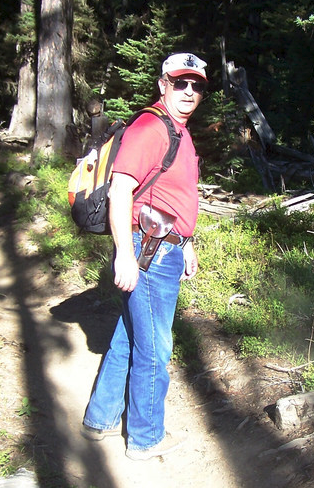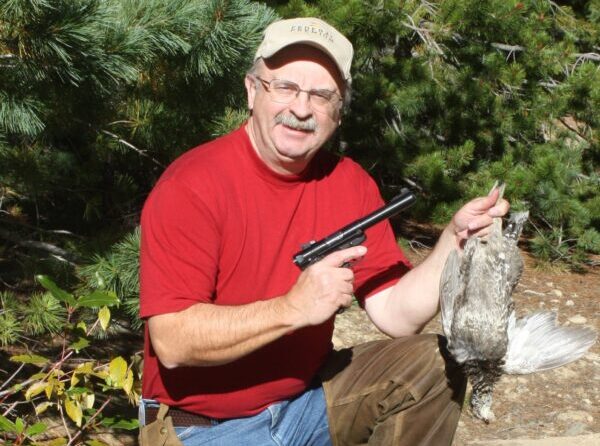
By Dave Workman
Editor-in-Chief
About this time of year, it’s never wasted time to break out a .22-caliber rifle or pistol—in my case a sidearm—and head for the gun range or somewhere out on public land, away from others, where you can find a safe backstop, and spend a leisurely morning or afternoon honing your shooting skills.
In my case, it invariably translates to maintaining my trigger control and marksmanship. Come grouse and small game seasons, which open in September here in the Pacific Northwest, I want to be able to put grouse and rabbits in the cooler.
Years ago, my handgunning was honed when I hunted raccoons with a hound hunter—a mentor named Bill Kersh—and it was a knack I never let go. I used a .22-caliber double-action Harrington & Richardson nine-shot revolver, while his sidearm was a Ruger semi-auto pistol. He was pretty good with it, and I think he was satisfied when I could pop treed ringtails with some regularity. I subsequently acquired an old Hy Hunter single-action .22-caliber six-shooter; an import that was never as good a revolver as the Colt single-action Frontier Scout or Ruger Single Six I coveted but never owned.
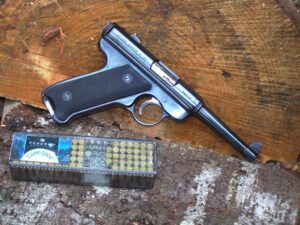
Some years back, while cruising the aisles of a gun show I stumbled upon a Ruger semi-auto Standard pistol, the gun that ultimately became the MKI model. The gun was in almost new condition save for a small ding on the butt where a previous owner apparently dropped it, but the finish was very good.
I plunked down some cash, sent my son to round up a spare magazine—which he did almost immediately—and went home with a smile. My find was a vintage 1963 model with fixed sights, and a trip to the range revealed this little gem with its 4.75-inch tapered barrel was deadly accurate at 25 yards using Winchester, Federal and Remington rimfire ammunition.
I’ve fed it a diet of 40-grain RNL rounds, but it also seems to like hollowpoints.
Its previous owner had not taken care to clean it much, so I opened it up and went to work with an old toothbrush, smallbore bronze bristle brush, Hoppe’s No. 9 and gun oil. It has functioned flawlessly ever since. I knocked together a full flap holster with an integral spare magazine pouch for the pistol, and it sees action every fall.
Anyone who has ever taken apart a Ruger Standard, MKI, MKII or MKIII knows they can be a pain in the neck when it comes to reassembly. Fortunately, today there are ample YouTube videos that make the process look simple, without explaining that some folks just can’t seem to get it right. Some time back, a pal of mine chuckled that the Ruger Standard is a pistol that comes apart in about a minute, but takes about 20 minutes to a couple of hours to put back together! Evidently, he’d had some interesting experiences.
Economically, using a rimfire pistol to pot small game is a smart strategy. Rimfire ammunition is much less expensive than shotgun shells of any gauge, including .410 bore. If one can master the smallbore, and it is legal for the taking of rabbits, grouse and other small game, you’re miles ahead owning one.
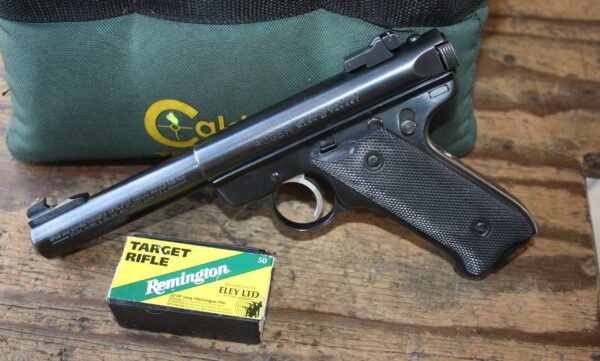
I’ve hunted with guys who always carried a .22-caliber handgun, especially when hunting deer and elk out here in the western U.S. I’ve potted grouse while deer and elk hunting, and the one time I didn’t have a .22 pistol, while hunting a late deer season north of Spokane years ago, I kept running into blue grouse, maybe a half-dozen of them over the course of a single afternoon. That taught me a valuable lesson.
I’ve rigged up a used nylon holster to the belt of my camo daypack into which a pistol fits nicely. Spare magazines go into a pouch on the other side. One never knows when a target of opportunity will appear while hunting for something bigger, and many is the empty stew pot that has been filled in a hunting camp thanks to good luck, good marksmanship and stupid birds or bunnies.
While I have one of the Standard models, my brother scored a MKII with a target barrel and sights, and he’s pretty good with it. A few years ago, I built a holster for that gun with its longer barrel, and he now carries it when we’re hunting.
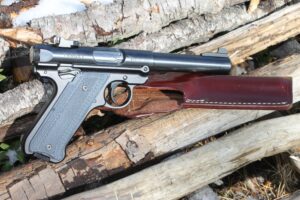
About six years ago, when Ruger introduced the MKIV “new and improved” version of its .22-caliber semi-auto, with a vastly improved takedown and reassembly system, I quickly acquired one for a test, and liking it, I bought it. It is also a target model with a 5.5-inch barrel, and I’ve been able to do some remarkable shooting with that handgun.
While the Standard model came with a 9-round magazine, the MKIV came with a 10-rounder, and instead of being retained in the pistol by a lever at the butt end, the MKIV features a traditional magazine release button behind the trigger on the left side of the frame. There’s also a small spring and plunger in the butt that helps push out an empty magazine for a quick reload, so it’s fun to shoot.
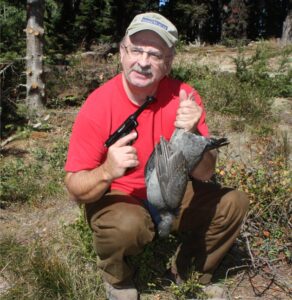
The payoff is in the early autumn. I’ve found that practicing with half-gallon milk jugs filled with water is a good way to improve your skills. This size of jug is a close facsimile to an adult grouse or fat cottontail. If you can hit the jug, you can hit the game.
For more challenging targets, save your quart milk cartons, fill them with water and staple them shut, and start shooting. For the next three months, you have plenty of time to practice. Check your local game regulations to be sure that taking small game with a rimfire pistol or rifle is legal, and if so, now’s the time to get cracking. You will spend some quality hours plinking at targets while improving your trigger control, breathing and sight alignment.

